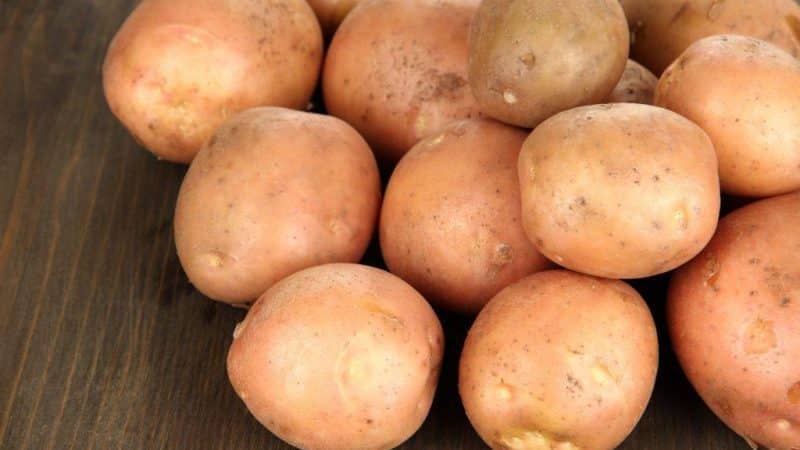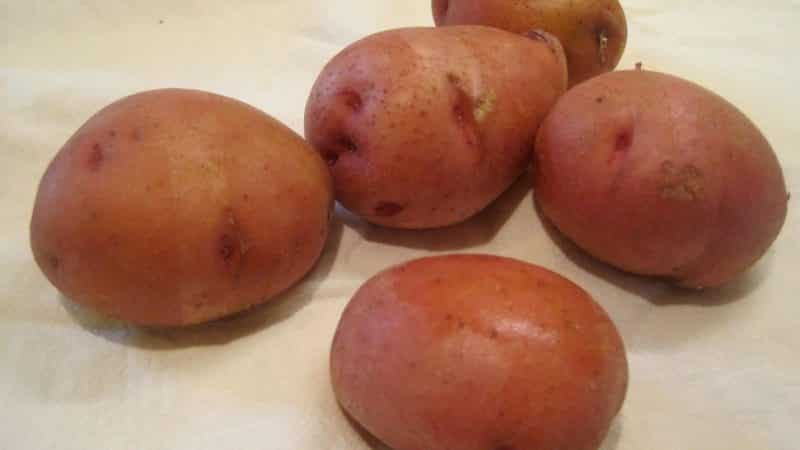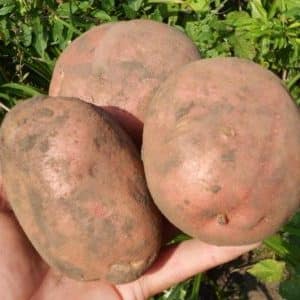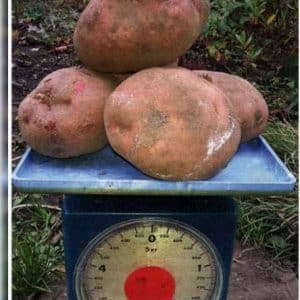Unpretentious mid-season potato variety “Irbitsky” from domestic breeders
We bring to your attention the Irbitsky potato variety. It appeared on the market relatively recently, but has already proven itself to be excellent. The variety is valued for its high yield, large fruit, resistance to adverse conditions, pests and diseases, ease of care and undemanding soil, excellent technical characteristics and taste.
Description of the variety
The originator of Irbitsky potatoes is the Ural Research Institute of the Russian Agricultural Academy. State testing of the variety began in 2009, as a result of work with SSE and Velox.
Irbitsky potatoes are included in the State Register of the Russian Federation for the Volga-Vyatka and West Siberian regions.
In the photo - Irbitsky potatoes.

Distinctive features, appearance
The variety is mid-season in terms of ripening: from germination to technical ripeness it takes an average of 70-90 days. Irbitsky potato bushes are of medium height, quite compact, semi-erect.
Type of growth – intermediate. The leaves are dark green, with wavy edges, larger than average. The corolla is average, with intense anthocyanin (blue-violet) coloring on the inside.
The round tubers have a pink-red skin color and yellowish pulp with a starch content of 13-16.5%.
Description and characteristics of the crop
From one bush, 6-8 (up to 10) large potatoes are collected, each weighing from 110 to 190 g.Productivity depends on agricultural technology and weather conditions, and is 250-400 c/ha. The quality of the crop is mainly influenced by 2 factors: planting material and landing site. If the material is purchased from a nursery, it does not even require preparation.
Reference. Small tubers are not suitable for planting, as they take a long time to adapt and grow slowly.
To increase productivity, gardeners mow the tops 1-2 weeks before harvest. It is then crushed and used as fertilizer.
The Irbitsky variety has high marketability - no less than 97%. Keeping quality never falls below 96%.
How to grow this variety
The Irbitsky variety is cultivated both on large areas for industrial use and on small garden plots.
Since the variety does not require care and can be grown even in unfavorable climatic conditions, it can be easily grown in your garden.

Dates, scheme and rules of planting
Three weeks before planting, potatoes are taken out of storage and sorted, removing diseased or rotten tubers. To germinate, they are left in a warm and bright place. Large tubers are cut so that each cut part has 2-3 eyes. They are treated with growth stimulants and drugs to protect against pests and diseases.
Important! For Irbit potatoes, acidic soil is more suitable than alkaline soil.
Potatoes are planted in an open, sunny place without drafts. The planting scheme is as follows: 60 cm are left between plants, 35 cm between rows. Tubers are placed in pre-dug furrows to a depth of 8-10 cm. Ash containing phosphorus and potassium, as well as ammophos or mullein, sources of nitrogen, are added to the holes. These substances are necessary for the development of the tuber and plant growth.
Planting tubers in unheated soil leads to their rotting and late germination (after about a month and a half), and being late in planting just a couple of weeks reduces the harvest by 20%. Therefore, determine planting dates with maximum accuracy.
Early planting is preferable, but the soil should already warm up to +7...+8°C. This time falls approximately in mid-May, not earlier. The best predecessors for this variety are legumes, cucumbers and pumpkin.
Care
Since in most regions hot and dry summer days alternate with cool and humid ones, it is not easy to develop a universal care scheme for the Irbitsky potato variety. However, there are agricultural practices that are standard for any weather. This includes loosening and removing weeds, hilling (it is necessary for the growth of lateral underground shoots on which tubers develop), watering and fertilizing with organic and mineral fertilizers.
The first loosening (before emergence) is deep - 10-12 cm. The second and third - no deeper than 6-7 cm.
The first hilling is when the plant height is 15-17 cm, the height of the soil ridge will be 18-20 cm. The second hilling is before the tops are closed.
It is recommended to combine watering and fertilizing with each other. It is enough to carry out these agrotechnical activities no more than three times per season:
- 2 parts chicken manure and 30 parts water. Before fertilizing, the soil should be moist so as not to burn the roots;
- 2 parts of chicken manure or mullein are diluted with 30 parts of water. This feeding is carried out during the formation of buds;
- 4 tablespoons of ash are mixed with 1.5 tablespoons of potassium sulfate per 1 linear meter. Treatment is carried out during flowering of plants.
One potato bush requires 1 liter of fertilizer solution
Nuances of cultivation and possible difficulties, diseases and pests
The Irbitsky variety deserves all 5 points on a 5-point scale for resistance to pests and diseases. However, some difficulties during cultivation cannot be ruled out:
- Colorado beetle. For prevention, tubers are treated before planting and/or bushes before flowering with the preparations “Alatar”, “Aktara”, “Prestige”, etc.

- Wireworm. Before planting, “bait” (pieces of potato, cake) with poisons are scattered over the area.
- Late blight. Brown spots appear on the leaves on top, and a white coating appears on the bottom. The disease affects all parts of the plant and occurs towards the end of summer, when the air temperature drops sharply and it rains. The virus quickly spreads from leaves to stems and tubers. The tubers become covered with hard brownish areas and then rot. To prevent the entire crop from being lost from this disease, diseased bushes are sprayed with a solution of Bordeaux mixture.
- Ring rot. The fungus attacks the vascular tissues of the stem and tubers. It looks like cream-colored circles with transparent glassy inclusions nearby. Careful selection of planting material and its treatment with fungicides is the best prevention of this disease.
- Scab. Irregular ulcers with a dry rim appear on the tubers. The fruits are stored for a long time, but dry out over time. Control measures include maintaining crop rotation, planting high-quality material and using fungicides in case of infection.
Collection, storage and use of crops
Since Irbitsky is a mid-season variety, the harvest is harvested in August. Be sure to dig up potatoes in dry weather.
After harvesting, the area is fertilized. Per 1 square meter add a bucket of humus or compost, 15 g of potassium salt and 30 g of superphosphate.
The tubers are laid out under a canopy and damaged and diseased specimens are rejected there.
Important! During the drying process, the tubers should not be exposed to light, otherwise they will turn green and become unfit for consumption.
Potatoes are sorted for storage for food and as planting material for the next year. Fold in 1-2 layers to dry.
The storage room for Irbit potatoes should have a temperature of 2-4°C and a humidity of 75%. Full ventilation of the cellar is important, since the tubers need air supply. Beets absorb moisture well from the surface of potatoes, so it is preferable to store them together. Only healthy tubers are stored for storage.
Variety Irbitsky - universal in application, the tubers have an excellent taste.
Advantages and disadvantages of the variety
Vegetable growers do not identify any shortcomings in the variety.
The variety has plenty of advantages:
- high yield - 250-400 c/ha;
- commodity indicators – 97%;
- excellent taste and versatility of use;
- keeping quality – 96%;
- practically not affected by diseases characteristic of potatoes;
- withstands pest attacks;
- drought- and injury-resistant;
- undemanding to soil;
- easy to care for;
- withstands unfavorable environmental factors.
The variety is unpretentious and does not require special cultivation techniques, but all traditional agrotechnical measures are required for it.
For which regions is it best suited?
The Irbitsky potato variety is intended for cultivation in the Volga-Vyatka and West Siberian districts. However, it is also widespread in Russia’s neighboring countries – Ukraine and Moldova.
Farmer reviews
The Irbitsky variety belongs to the “super-elite” category.It has a lot of advantages, thanks to which it receives mostly positive reviews.
Olga, Zaozerny: «Irbitsky potatoes are a wonderful variety that pleasantly surprised me with an early and abundant harvest. The tubers are large, crumbly and tasty. This is one of my favorite potato varieties."
Maxim, Kodinsk: “I like to experiment with potato varieties and have been doing this for a very long time. I have already seen many different varieties on my plot, but Irbitsky is distinguished by its early and large-fruited harvest.”
Natalya, Michurinsk: “I recently bought a garden plot that had bad soil. The first thing, of course, I planted potatoes there. All other varieties produced small tubers. And Irbitsky distinguished himself with a large harvest and large tubers. And this despite the fact that I didn’t water it or feed it with anything! I’m happy with this variety of potatoes.”
Read also:
Farmers' favorite potato variety is Lasunok.
What are the benefits of potato juice for hair and how to use it.
Conclusion
The Irbitsky potato variety is resistant to common potato diseases and pests and has proven itself when grown in unfavorable conditions. If you follow simple rules of agricultural technology, you will get a harvest of high-quality, large tubers.